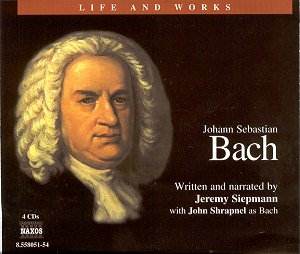Naxos has been an invigorating force on the recorded
music scene for several years now, at a time when one was sorely needed.
And the innovations continue with issues such as this four-disc set
exploring the life and music of Bach.
The project is the work of Jeremy Siepmann, who features
as both writer and narrator. There are four well-filled CDs which explore
Bach's life and times in an essentially chronological sequence. Siepmann
narrates and there is a good pacing of text and delivery, with generally,
though not consistently, well chosen music examples taken from the extensive
Naxos catalogue. If not necessarily top recommendations, the performances
are always more than acceptable.
Siepmann brings Bach's chronicle to life with well
judged balancing of historical fact and anecdotes. John Shrapnel makes
regular contributions as the voice of the composer, and more occasionally
other voices add to the atmosphere of time and place. Music examples
emerge naturally out of the narrative, and though the performers are
not announced in the manner of a radio broadcast, the 116-page accompanying
booklet contains chapter and verse about the chosen performances. There
is, however, precious little information about the recording circumstances
of the project itself.
One of the inevitable drawbacks with a set such as
this is that the company's catalogue may not necessarily contain the
music the text requires as accompanying example. It is a tribute to
the richness and depth of the available repertoire Naxos has assembled,
that only once does this issue loom large. It is when Siepmann deals,
in the context (his chosen context) of Bach in Weimar, with the influence
of Vivaldi. The spread of Vivaldi's published music to northern Europe
(it was frequently published and printed in Amsterdam) was admittedly
an important phenomenon, and Bach showed his interest through one of
his favourite compositional devices: parody. This was the art of bringing
a new identity to music by reusing it in a new context. Vivaldi's twelve
concerti, Opus 3, known as L'Estro Armonico, were arranged by Bach in
various ways, mostly as organ pieces. But this set includes as the music
example the four harpsichords concerto Bach composed in the 1730s for
the Collegium Musicum at Leipzig. Moreover this is included quite without
explanation, as if implying the music was composed for Weimar twenty
years before.
Sometimes musical issues emerge which are passed over.
One is the use of the piano rather than the harpsichord. There is, for
example, an example from a keyboard invention which is played on the
piano, quite without explanation. Now I am all in favour of Bach on
the piano, but in an historical survey performing styles and issues
of authenticity surely ought to have a higher profile than they receive
here.
In the case of The Musical Offering, the somewhat austere
chamber music sequence Bach composed for Frederick of Prussia in 1747,
a misleading impression is given of the nature of the music. This results
from the chosen example, which is the lively Allegro of the central
trio sonata movement. One of the various canons which dominate the work
would have given a more typical impression.
However, these are relatively insignificant points
in the context of a whole project spread across four CDs. The listener
is led along with an intelligent balancing of words and music; and Siepmann's
style is just right, neither patronising nor wordy. The set is also
excellent value, with a substantial and well produced booklet which
contains a wealth of useful information.
Terry Barfoot


